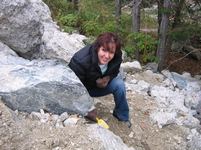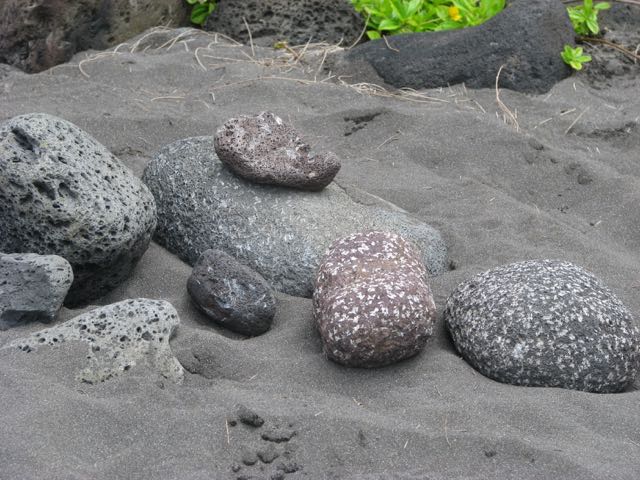Know Your RocksKnowing about the rocks on your farm can really help you to understand the mineral components of your soil. That mineral component is so important, but often overlooked as most folks go about improving their soils. However, it's the minerals that provide most of the vital elements needed for plant growth. So lets have a closer look at the rocks and minerals that you might find on your farm. Rocks in GeneralAll the rocks on our planet can be divided into three major groups. Igneous - Rocks that formed from the cooling of molten rock either below ground (plutonic rocks like granite or gabbro) or above ground (volcanic rocks like basalt or rhyolite) Sedimentary - Rocks that formed from the cementing together of cobbles, sands, silts or mud size particles into layers of rocks. Most of these are formed in the oceans on the margins of the continents where these materials have have washed from the land in rivers such as sandstone, shale, conglomerate or built up from the remains of animals like limestone. Metamorphic - Rocks that are formed from the squashed and/or cooked (but not melted) remains of other rocks. These are usually found where mountains formed, continents collided, or close to huge masses of molten material. Rocks like schists and marbles, quartzites and gneisses.  My wife Jen and I love to collect minerals. Here she is amongst granite boulders in Maine looking for tourmaline. My wife Jen and I love to collect minerals. Here she is amongst granite boulders in Maine looking for tourmaline. All of these rocks are made up of a mix of common minerals: Quartz Felspars Mica Amphibole Pyroxene Olivine Calcite Plus, a splattering of minor minerals. Here is a table of just a few of the common rock types and the minerals they contain: Rock type Rock Name Minerals Igneous Granite Quartz, Feldspar, Mica Igneous Rhyolite Quartz, Feldspar, Mica Igneous Basalt Amphibole, Feldspar, Pyroxene, Olivine Metamorphic Marble Calcite, Metamorphic Schist Mica, Quartz, Metamorphic Gneiss Quartz, Feldspar, Sedimentary Sandstone Quartz, Feldspar, Mica, Clays Sedimentary Shale Clays Sedimentary Limestone Calcite Once a rock is exposed to the weather it will start to break down "physically" into smaller grains, and "chemically" into different minerals. These major rock forming minerals break down into the following (lesser/minor) minerals. These are the minerals that you will find in your soils: Original Mineral New Mineral Released Elements Quartz Quartz Felspars Clays Potassium, Sodium, Calcium Mica Clays Potassium Amphibole Clays, Iron Pyroxene Clays, Iron Olivine Clays, Iron, Magnesium Calcite & Dolomite Calcite, Calcium, Magnesium What this means for you...So, if you know that much, you can figure the following: If you you live in an area where granite is the dominate rock type (a rock containing quartz, feldspar and mica), you will find your well-developed soils contain quartz, grains, and clays. Less developed soil will appear sandy as the feldspars have not yet broken down into clays. The soil will contain potassium, sodium and calcium. If your homestead is on basalt, you will have clay rich soils with loads of iron and magnesium. The best way to find out what kinds of rocks you have in your area is to visit your national or state’s Geological Survey. To find those in the USA go here (http://www.stategeologists.org/). They will have maps (many online) and advice to help you discover whats under your feet. What ever rock type you have on your farm will directly affect the type of soil you have to work with. With a little love and care, any soil can be amended with fertilizers and organic matters to create fertile, workable ground. It just helps to know what you are starting with!
4 Comments
6/8/2015 10:46:25 am
In my opinion you are not right. I suggest it to discuss. Write to me in PM, we will communicate.
Reply
11/17/2015 09:16:23 am
Stones of your homestead can truly assist you with understanding the mineral parts of your dirt. That mineral part is so vital, however frequently neglected as most people improve their dirt's. Here is interesting sharing about the rocks that is really amazing.
Reply
Thanks for helping me understand that you can find the kind of rocks you have in your area by visiting the national survey. I will share this information with my sister since she plans to use dolomite for her property. It seems that she has been inspired by what she saw in a magazine.
Reply
Leave a Reply. |
Lindsay Hodge
Lindsay Hodge is our resident Writer here at Haven Homestead. She keeps this blog, a GRIT blog, and writes other fun things too. Categories
All
Archives
May 2018
|




 RSS Feed
RSS Feed
